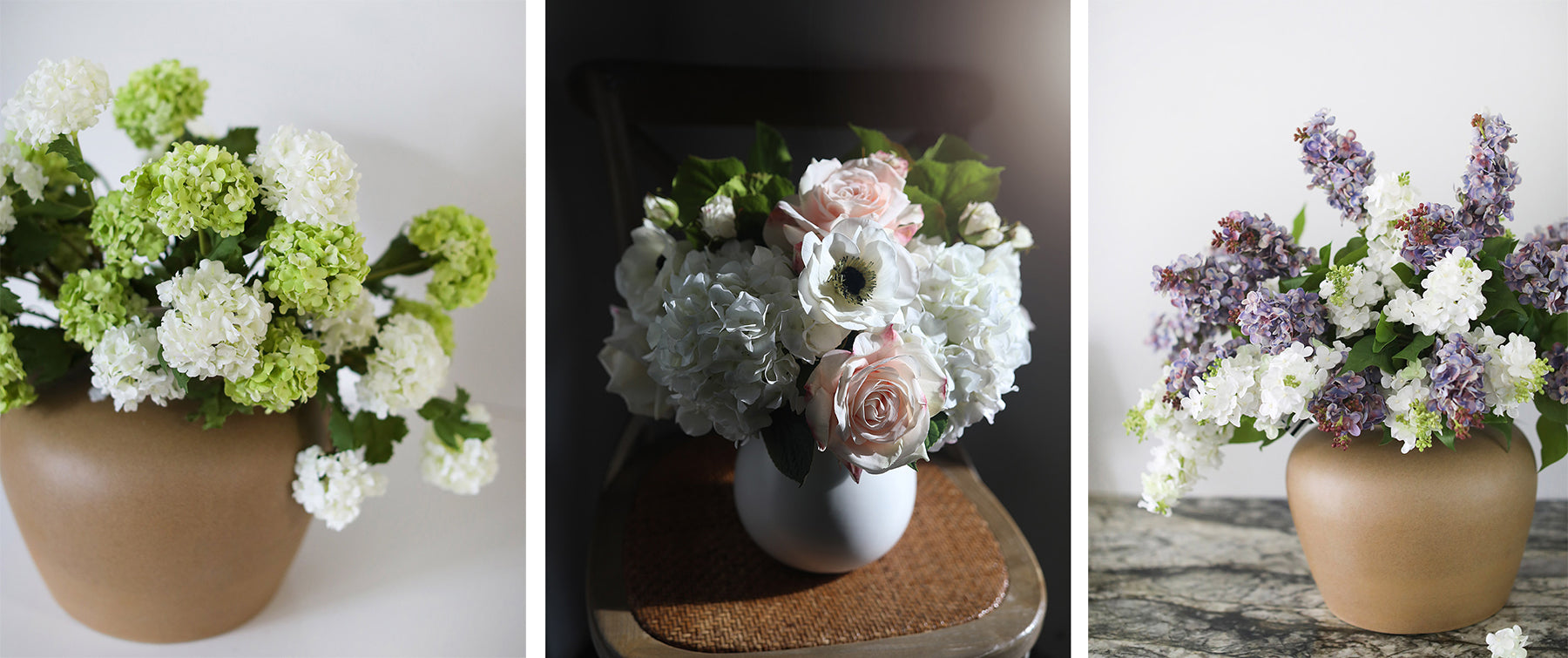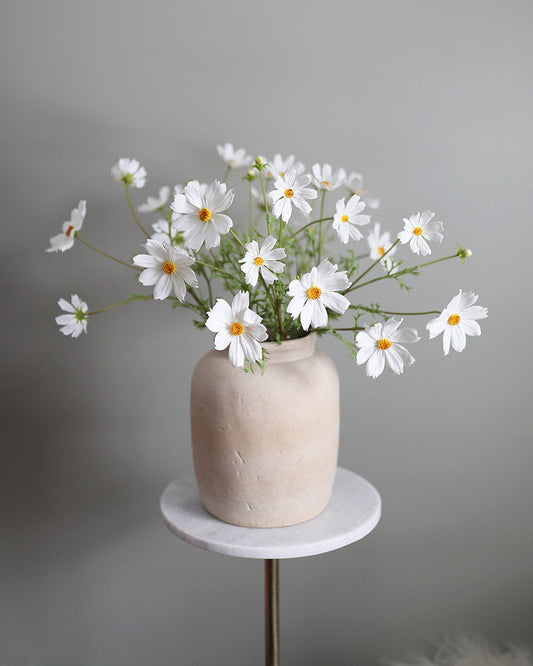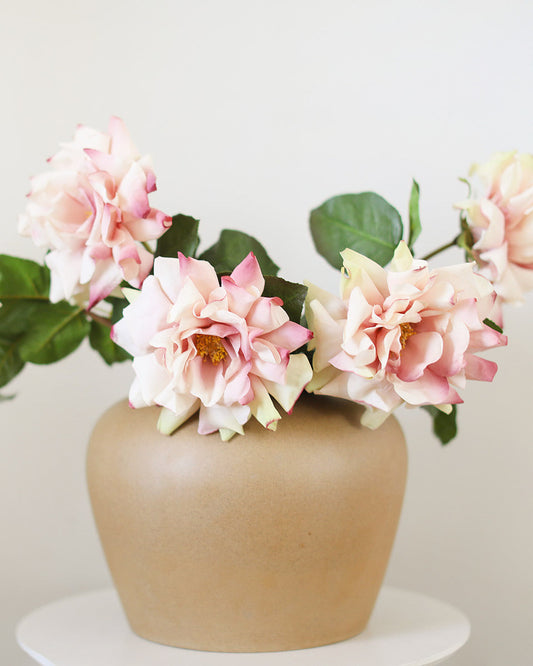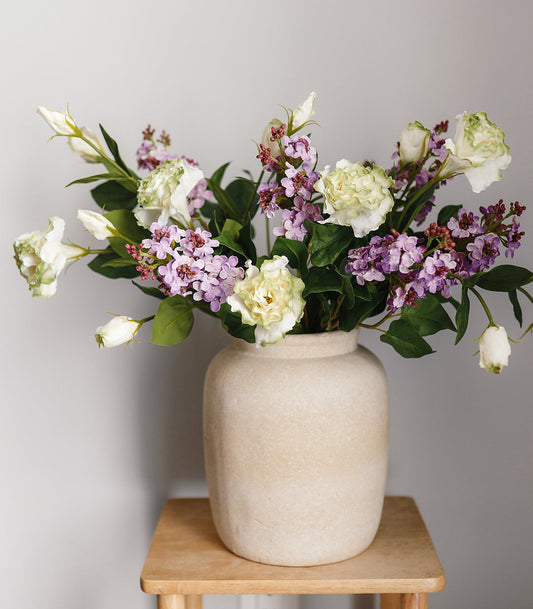In Full Bloom: Answering The Most Common Faux Flower Questions

Faux flowers have become a popular choice for home decor, events, weddings, and more, however, with the wide array of options available, it's natural to have questions about these lifelike blooms. Let's explore the most commonly asked questions about artificial flowers, addressing everything from their realistic appearance to the best ways to care for them, helping you make informed decisions for your floral decor.
WHICH ARTIFICIAL FLOWERS LOOK THE MOST REAL?
The most lifelike faux flowers are real touch florals. Real touch flowers are made from high-quality, durable materials (latex or polyurethane blend) that mimic the velvety softness of a real blooms's petals and capture subtle nuances like veining and natural gradients. This level of craftsmanship ensures that each artificial flower looks incredibly realistic, making them a popular choice for those seeking a long-lasting and authentic floral display. The popularity of real touch flowers can vary based on trends and personal preferences, however, among Prestige Botanicals customers, roses, orchids, anemones, and hydrangeas stand out as some of the most sought-after premium flowers.
WHY FAUX FLOWERS CAN BE BETTER THAN FRESH?
Faux flowers offer several advantages over fresh blooms that make them a preferred choice for various settings. They are long-lasting and do not wilt or perish like real flowers, making them ideal for decorations that need to maintain their appearance over time.
Artificial flowers require minimal maintenance compared to fresh flowers, as they do not need watering or trimming, and won't wilt. This low-maintenance aspect makes them convenient for busy individuals or for spaces where regular upkeep can be challenging. Fake flowers are also allergen-free, making them suitable for people with pollen or scent allergies.
Artificial florals provide versatility in terms of availability, as they are not limited by seasons or geographic locations. While there is an initial cost for high-quality faux flowers, they are actually cost-effective in the long run because of their reusability and durability. You can enjoy the beauty of faux botanicals year after year.
Lastly, faux flowers come in a wide range of colors, styles, and types, allowing for endless creativity and customization in home decor, floral arrangements, and bridal bouquets -- without worrying about keeping the flowers fresh or being limited by seasonal availability.
ARE ARTIFICIAL FLOWERS TACKY OR OUT OF STYLE?
The quality of faux flowers has advanced significantly in recent years, moving far beyond the tacky and outdated designs of the past. Modern faux flowers are made using high-quality materials that closely mimic the look and feel of real blooms. They feature lifelike textures, colors that mimic nature, and intricate designs that make them indistinguishable from fresh flowers at a glance. This advancement in quality has made faux flowers a popular choice for interior decor, events, and weddings, as they offer durability, low maintenance, and endless design possibilities. Artificial flowers have become a timeless and stylish option that continues to be embraced by designers and individuals seeking long-lasting floral arrangements that look (and feel) like the real deal.
HOW DO I CLEAN AND STORE MY FAKE FLOWERS?
Some quick and simple ways to clean your faux florals are to use a duster, baby wipes, or even a hair dryer on a low heat setting. For a deeper clean, a little water and dish soap will do the trick!
To store your florals, we recommend wrapping them in paper, place in a box/container, and storing them in a cool, dry location.
Learn more about how to clean and store your artificial flowers.
HOW CAN I TRIM OR SHORTEN THE FAUX FLOWER STEMS?
Faux flower stems often include a wire core that provides stability and flexibility for shaping and arranging. The wire is then covered with other materials to enhance the overall appearance and realism. The most common material for a faux flower stem is plastic, however polyurethane and latex are used on occasion. Wired stems are generally easy to cut and trim using sturdy wire cutters, stems without wire can be cut with wire cutters or a heavy duty pair os scissors.
CAN I SHORTEN THE STEMS WITH CUTTING THEM? WHAT IF THE STEM IS TOO THICK?
Oversized or exceptionally tall artificial flowers often come with a thicker wire inside their stems, which provide robust support for taller branches and bigger blooms, but can make cutting the wire more difficult. Additionally, you might not have a pair of wire cutters available. In these instances, you can simply bend the wired stems to achieve the desired height. Be mindful that the bulkier stem may occupy more space within your vase, and if using a transparent vessel like glass, the bent stems will be visible.
WHAT IS THE BEST WAY TO STYLE ARTIFICIAL FLOWERS IN A VASE?
- Start by selecting a vase that complements the size and style of your artificial flowers. The vase should be proportionate to the length and volume of the stems.
- Create your flower designs using odd numbers (3, 5, 7). Odd-numbered groupings tend to look more natural and organic, resembling how flowers often grow in nature. This asymmetry adds a sense of movement to the arrangement. Odd numbers also create a balanced visual composition by preventing symmetry, which can sometimes appear static or too formal.
- Vary the heights of the flowers and stems to add dimension and depth to the arrangement. Taller flowers can be placed towards the back or in the center, while shorter ones can be placed towards the front or sides.
- Optional: Add a base of artificial foliage or filler flowers before adding in your focal florals. This can help create a natural, full appearance and also provides stability for the other stems.
- Decide if you want a monotone or contrasting floral piece. With a monotone design, focus on a single color or varying soft shades of a particular hue (pale blush or creamy yellow).
- For a higher contrast more colorful display, use a mix of different flower colors and textures (buds, artificial berries) to add depth and realism to the arrangement. Combining blooms with varying shapes, sizes, and hues creates an eye-catching, dazzling display.
- After placing all your flowers in the vase, adjust and fluff the petals and leaves to achieve a natural and lifelike appearance. Gently bend and arrange the stems (and leaves when possible) to create an organic look.
CAN FAUX FLOWERS BE USED OUTSIDE?
While artificial flowers are typically not designed for outdoor settings, they can be effectively used in arrangements or pots that are placed on a covered porch, deck, or other areas shielded from weather. It's important to note that prolonged exposure to bright sunlight will cause fading, especially for flowers with vibrant colors. Artificial florals exposed to outdoor elements like rain and wind, will show signs of wear and tear over time.
CAN ARTIFICIAL FLOWERS GET WET?
Faux flowers are not designed to withstand prolonged exposure to water, however they can tolerate light moisture or occasional cleanings. Excessive exposure to water can cause damage to the materials; color bleeding, material breakdown, etc. It's best to keep artificial flowers away from direct contact with water to maintain their appearance and longevity. If they do get wet or you are cleaning your florals, be sure to gently pat them dry and allow them to air out.
*Be cautious when cleaning artificial flowers with deep or rich colors, as the color may bleed in water. Before submerging them, test a small, inconspicuous area to ensure the colors won't run.
CAN FAKE FLOWERS BE SPRAY PAINTED OR USED IN RESIN?
Artificial flowers can be spray painted to alter their color or add a certain aesthetic to them. When considering spray painting your florals, here are a few tips:
- Be sure to use the proper spray paint! Select a paint that is designed for artificial materials; plastic, fabric, latex.
- Clean your artificial flowers before spraying. Be sure to remove any dust or dirt from the petals.
- When painting your florals, be sure to use thin layers of paint to avoid any pooling or dripping. Hold the can about 8-12 inches from the bloom and apply in light, even coats. Allow paint to dry completely before applying another coat.
- Optional: Once the desired look is achieved and the paint is completely dry, you can apply a clear top coat or sealant to protect the paint and enhance its durability. Top coats are usually available in a variety of finishes; glossy, matte, etc.
Faux flowers can also be used in resin! Choose artificial flowers that are made of materials that can withstand the resin curing process. Silk/fabric, and plastic flowers are commonly used for this purpose as they are more resistant to heat and chemicals. With flowers that are rich in color, some color bleeding may occur. We recommend a gentle cleaning of the petals beforehand and always do a test before starting your full resin project.
WHERE CAN I BUY ARTIFICIAL FLOWERS?
You have come to the right place! Here at Prestige Botanicals we offer high-quality, lifelike faux botanicals that are ideal for enhancing your home decor, event settings, creative DIY projects, and more. Shop here for all our faux flowers.







